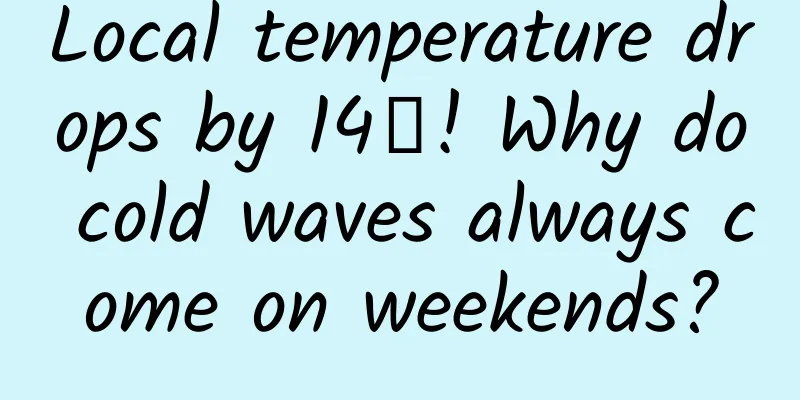Local temperature drops by 14℃! Why do cold waves always come on weekends?

|
November 20-23 The third round of cold wave this winter will sweep across most parts of my country Anhui, Jiangsu, Jiangxi and other places The local cumulative temperature drop may exceed 14℃ Morning of the 23rd The 0℃ line will reach the middle and lower reaches of the Yangtze River Two-thirds of my country's territory will be frozen by the cold wave Let's take a look at this national freezing line progress map See when your home will be "frozen"? 5:00 this morning The cold front has reached the western Hebei to western Henan area Affected by Eastern Xinjiang, Qinghai, Gansu, and western Inner Mongolia Central and northern Shaanxi, southern Shanxi, southern Hebei, etc. A temperature drop of 4 to 8°C occurs The temperature in Xinjiang and Gansu dropped by 10-13℃ On November 21, snow fell in Panjin, Liaoning Province. The road was slippery. Please pay attention to safety when traveling. Photo by Li Jian Affected by the cold wave, snow fell in Chongli, Hebei on November 21. Photo by Wang Xuhai Xinchengzi Town, Miyun District, Beijing Jiangshuihe Village at the foot of Lingshan Mountain in Mentougou District It's snowy ▼ It snowed in Xinchengzi Town, Miyun District. Source: Beijing Daily Snow falls in Jiangshuihe Village at the foot of Lingshan Mountain. Photo by Zhou Yongtang Source: Beijing Daily The Central Meteorological Observatory predicts Next 48 hours Cold air moves south quickly Affects most of the central and eastern regions of my country East China will become a strong cooling center Today 9:00 Temperature distribution across the country, hourly maximum wind speed The actual situation is as follows ▼ Today 10:00 The Central Meteorological Observatory issued three warnings simultaneously! Cold wave! Blizzard! Strong wind at sea! Blue warning for cold wave ▼ Affected by the cold wave, from 14:00 on November 21 to 14:00 on November 23, there will be northerly winds of 4 to 6 levels, with gusts of 7 to 9 levels in central and eastern China, and the temperature will drop by 6 to 10℃. Among them, some areas in the eastern part of Huanghuai, Jianghuai, and eastern Jiangnan may experience a temperature drop of up to 12℃, and above 14℃ in some local areas. On the morning of the 23rd, the lowest temperature of 0℃ is located in the middle and lower reaches of the Yangtze River to the northern part of the Sichuan Basin, and the lowest temperature in southern Jiangnan will drop to around 4℃. There will be strong winds of 7-9 and gusts of 10-11 in the eastern and southern sea areas. Yellow Blizzard Warning ▼ It is expected that from 14:00 on November 21 to 14:00 on November 22, there will be heavy to severe snow in northeastern Liaoning, central and eastern Jilin, and central and eastern Heilongjiang. Parts of eastern Jilin and eastern Heilongjiang will experience heavy snow and local extremely heavy snow (30-38 mm). The new snow depth in some of the above-mentioned areas will be 5-15 cm, and may reach more than 25 cm in some places. In terms of precipitation, as the cold air continues to move southward and converges with the low-level warm and humid air flow from the south, there will be a large-scale precipitation in southern China today , including heavy rain in northern Chongqing, southern Hunan, and northern Fujian. In the next three days, the center of snowfall will be stable in the Northeast . Most areas will have light to moderate snow or sleet, and some areas will have heavy snow. Among them, parts of eastern and northern Heilongjiang, eastern and northern Jilin, etc. will have blizzards, and some local areas will have heavy blizzards or extremely heavy blizzards (30-40 mm). Yellow warning for gale at sea ▼ It is predicted that due to the influence of the cold wave, from the afternoon of the 21st to the noon of the 22nd, there will be strong winds of 8 to 9 and gusts of 10 to 11 in Bohai Sea, Bohai Bay, Laizhou Bay, Bohai Strait, most waters of the Yellow Sea, the coastal waters of Shandong Peninsula, most waters of the East China Sea, the waters near the Yangtze River estuary, the coastal waters of Zhejiang, the Taiwan Strait, and the sea east of Taiwan. Meteorological experts remind that due to the influence of cold air, the temperature in most parts of central and eastern China will be significantly lower tomorrow, especially in Jianghuai, eastern Jiangnan and southern China. The temperature will continue to rise afterwards. The temperature will fluctuate frequently in the near future, so you need to adjust your clothing in time and be careful to prevent colds. In addition, the precipitation phase in Northeast China is mainly pure snow ,** and the precipitation in some areas of central and eastern Heilongjiang may break the historical extreme values for the same period . It is also necessary to prevent the adverse effects of blizzards on transportation, production and life in advance. Looking back at the two cold waves that occurred in the second half of this year (October 14-17 and November 4-9), we will find that they both "targeted" the weekend. ↑ From November 7 to 8, the three provinces in Northeast China and Inner Mongolia suffered from continuous heavy rain and snow. The depth of snow in many places broke the local observation record, reaching about half a meter in some places. The picture shows Tongliao "closed the door" due to snowfall. Why do cold waves always come on weekends? To be honest, it's just a coincidence of timing. Of course, this article will not stop here. Although the cold wave will not specifically "come" on the weekend, there are indeed signs of the occurrence of cold air in autumn and winter. Let's take a look at the 500hPa height field + sea level pressure field regional map at 08:00 on November 22. The most prominent isobar is the high-pressure ridge, and the most downward-curved part is the low-pressure trough. (Based on the 500hPa altitude field + sea level pressure field regional map of the Central Meteorological Observatory on November 19) Generally speaking, the areas controlled by the high-pressure ridge are dominated by downward air currents, with mostly sunny weather and rising temperatures. In front of the low-pressure trough, there are mostly upward air currents, and combined with water vapor, rain and snow occur frequently. The cold air moves eastward and southward along the ridge behind the trough, affecting my country. This thousands of kilometers long trough is a long wave of the atmosphere, and its period is about 3 to 5 days , which makes the cold air activity in winter also have a certain regularity. The period and intensity of cold air are affected by the strength of the trough. If a cold air happens to catch up with the weekend, it is possible that a new cold air will hit the next weekend. If we expand our perspective and look at the entire westerly circulation from this section of atmospheric long waves, we will find that these trough-ridge activities have been taking place in various regions in the middle and high latitudes of the Northern Hemisphere. ↑ The powerful cold air that will affect my country over the weekend is the high-altitude trough system in the red circle in the picture. It is obviously "prominent", and the deep trough means that the cold air it guides will also be stronger. (Based on the Northern Hemisphere Air Pressure Field Map of the 500hPa Height Field of the Central Meteorological Observatory on November 19) In most cases, they move from west to east in the westerly belt. The shorter the wavelength of the trough and ridge, the faster the movement speed, and the longer the wavelength, the slower the movement speed. Sometimes they even stagnate or reverse. This also explains well what is meant by "the whole world is the same in terms of cold and heat". As the trough moves, cold and heat occur simultaneously, but in different places. In North America, Europe and Asia, affected areas will see "sunrise in the west and rain in the east", with warming and cooling occurring alternately, and sometimes showing a certain periodic regularity. However, at a time when "extreme weather has become the new normal," trough-ridge activities have taken on new characteristics—they are more prone to large fluctuations and large amplitudes, which are manifested in the constant occurrence of extreme conditions of extreme cold or warmth. The cold wave from January 5 to 8 at the beginning of this year caused many places in the north to set new records for the lowest temperatures since meteorological records began. However, in February that year, the north experienced an epic warming recovery, with many places setting new records for the warmest temperatures during the same period. Map: Luo Jiaxue, China Weather Network This cold and warm is not only directly reflected in the temperature, but also indirectly affects the occurrence of other extreme weather events. For example, the multiple tornadoes that occurred in June this year were a reflection of the fierce confrontation between warm and humid air currents and cold air, and occurred against a background of great warmth; for another example, the extreme heavy rainstorms in Henan this year also showed warm characteristics, and the extreme warm and humid water vapor made it possible for record-breaking rainfall. Why are such extreme cold and warm periods occurring so frequently this year? Looking at each weather process individually, its occurrence is influenced by different factors. However, if we explore the deep-seated reasons that affect the large temperature fluctuations in my country, in addition to Siberia, which is often called the cold air "gas station", we must also pay attention to the more distant Arctic region. Under normal circumstances, due to the large temperature difference, the high altitude in the Arctic region is usually dominated by a low-pressure system (i.e., the polar vortex), while the relatively warm mid-latitude regions are dominated by a high-pressure system. The obvious pressure difference will lead to a strong westerly jet stream, which "encircles" the polar cold air and prevents it from expanding southward. At the same time, it will also make the trough-ridge activity in the westerly belt relatively stable. ↑ Under normal conditions, the polar vortex is surrounded by the westerly belt and is relatively stable, so it is not easy for cold air to move south. (Map by China Weather Network) However, climate warming has changed this situation. Due to the amplification effect in the Arctic, that is, the warming in the Arctic is more obvious than in other regions, resulting in a smaller temperature difference between the polar and mid-latitude regions and a weakened pressure difference. On the one hand, cold air can more easily invade southward, and on the other hand, the meridional circulation pattern in the mid-latitude regions is strengthened, making it more likely for large ridges and deep troughs to appear, which is more conducive to the southward movement of polar or high-latitude cold air masses along the deep troughs. ↑ Under abnormal conditions, the pressure difference weakens, the polar vortex weakens or deforms and collapses, and cold air is more likely to move south. (Map by China Weather Network) In this case, the polar cold air mass can even directly enter my country's northeastern region, causing severe weather such as cold waves and blizzards in a large area of the north, and can further spread southward to cause a large-scale cooling in my country's central and eastern regions. This is the case with the super cold wave that broke temperature records in many places in the north from January 5 to 8 this year. ↑ From the forecast of AO (Arctic Oscillation, which refers to the difference in air pressure between the mid-latitudes of the Northern Hemisphere and the Arctic) index given by NOAA, it will continue to decline in the coming period, which means that cold air/cold waves in the Northern Hemisphere may still be active in the future. It is expected that after this wave of strong cold air passes over the weekend, some additional cold air will continue to affect my country. Although it is still unclear when the next wave of severe cold air will come, at least for now, we can answer: Cold waves do not choose to come on weekends, but if climate warming intensifies, we may encounter more "coincidences" of cold waves "delivered" from the polar regions in the future. This cold wave has a wide impact on the Long cooling "standby time" Friends Take out your down jacket and put on more clothes to keep warm! References: Liang Sujie, Study on the interdecadal changes of winter temperature, winter monsoon and regional circulation in China in the past 50 years[D], Chinese Academy of Meteorological Sciences, 2014 Zhu Qiangen, Lin Jinrui, Shou Shaowen, Tang Dongsheng, Principles and Methods of Meteorology[M], Meteorological Press, 2001 Zhu Chenyu, Huang Fei, Shi Yunhao, Dang Zhenzhong, Zhang Yuxuan, Spatiotemporal characteristics of cold waves in China in the past 50 years and their relationship with Arctic sea ice[A], Journal of Ocean University of China, 2014 Comprehensive sources: Central Meteorological Observatory, China Meteorological News Agency, China Weather Network, China News Network, etc. |
Recommend
Optimize 200 series AMD releases the latest 15.7 WHQL driver
AMD has released the latest graphics card catalys...
It's getting hot, beware of this type of food poisoning! The mortality rate is over 50%, many people love to eat
Summer is coming Friends who love to eat noodles ...
The ocean is running a fever: Will extreme weather bring us into an era of "boiling"?
The ocean is one of the most important parts of t...
The core logic of promotion on channels such as Baidu and Douban
Previously we talked about the definition of thir...
How can brand marketing on Children’s Day focus on “older children”?
Abstract: Children's Day is approaching. Inst...
Tips for building a private domain traffic personal account operation system
Under the influence of the 2020 epidemic, China&#...
Can’t come up with the copy for information flow advertising? There is a template here, just use it!
Many friends often complain to me: " Informa...
How to use Zhihu to effectively attract traffic and promote products?
What kind of platform is Zhihu? To study traffic ...
Learn design patterns for fun, say goodbye to bad code, and become a programming "artist"
Learn design patterns for fun, say goodbye to bad...
Tik Tok operation planning program for real estate industry!
1. Industry Background As we all know, in the tra...
If you feel uncomfortable, please put down your phone! These messages are silently causing harm
Audit expert: Li Xianhong National Level 2 Psycho...
China Automobile Dealers Association: A brief analysis of the used car market in June 2024
Overall performance of the used car market in Jun...
A fatal obstacle! Don’t delay if the elderly or children have these symptoms!
Audit expert: Qu Bo Chief Physician of General Su...
Practical techniques for obtaining effective traffic in early Internet startups!
Practical methods for obtaining effective traffic ...
Tips on how to get an operational plan with millions of PVs!
There are two types of information platforms on t...









